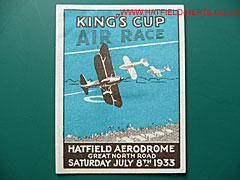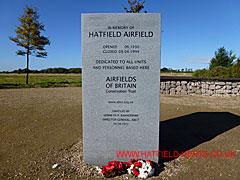 Aviation
and Aerospace in Hatfield
Aviation
and Aerospace in Hatfield
For people interested in the history of aviation – and the history of British aviation in particular – Hatfield Aerodrome (later called Hatfield Airfield) is sacred ground as home to The de Havilland Aircraft Company, which later became part of Hawker Siddeley and then British Aerospace. Aviation and aerospace are two of humanity's success stories of the 20th Century. From the first heavier-than-air powered flight by the Wright Brothers in 1903 to the Apollo Moon landing in 1969, never before in human history have we gone so far in such a short space in time – literally out of this world.
Please note: a number of entries in this section are links to information published in other parts of the site (particularly under 'Claims to Fame'), so for some links you will probably need to use your browser 'Back' button to return to the original page.
Sir Geoffrey de Havilland
Hatfield's main aviation and all its aerospace claims are firmly grounded in the 20th Century. While many brave, dedicated and intelligent men and women have contributed to Hatfield's aerial saga, one man and name stands out above them all, and that is Captain (later Sir) Geoffrey de Havilland.
Sir Geoffrey designed, made, and flew or more accurately crashed his first plane in 1909. His second aircraft was more successful and he taught himself to fly in it. In 1912 he established a British altitude record of 10,500 ft in one of his own designs. After briefly seeing active service in the Royal Flying Corps, he established a name for himself as a successful aircraft designer with Airco (originally The Aircraft Manufacturing Company). His designs accounted for around 30 per cent of UK and US aircraft produced during WWI. After Airco closed in 1920, he set up The de Havilland Aircraft Company. His Moth aircraft with Major Halford's Gipsy engines were a huge success. By the time the company bought the land and moved part of their flying operations to Hatfield in 1930, it was a multi-national company. Captain Geoffrey de Havilland was knighted in 1944.
Hatfield's (or at least the District of Hatfield's) involvement in mankind's desire to ape the birds actually dates back to the 18th Century. Although it was an unplanned and very brief episode in the first ever manned balloon flight in English skies it makes Hatfield one of the oldest aviation sites in Britain (and the world).

Commemorative beer label for the King's Cup Air Race held at Hatfield on Saturday, 8 July 1933. This was the first major aviation race to be held at the airfield. The race was won by Captain Geoffrey de Havilland.
Aircraft are more than just a mode of transport. Especially, those made famous through the exploits of their pilots or featuring some new technological breakthrough. In the 1930s with air travel becoming more popular and aircraft simple enough to fly by inexperienced pilots, like Amy Johnson (the first woman to fly solo to Australia), the world was aviation mad. Pioneering and record breaking pilots and designers were A-list celebrities. The aircraft they flew became cultural icons.
Aircraft, like the DH.88 Comet Racer, have been immortalised as models, paintings, badges, plastic kits, featured on book and magazine covers...While the real aircraft is preserved at Shuttleworth. Many aircraft and their pilots have featured on stamps, coins and cigarette /collectors cards. While a number of the artists, authors and photographers that have covered these aircraft have become or were already famous. With the sad demise of the British aviation history, the few surviving aircraft form pride of place in aviation collections and museums. While the even smaller number that are still airworthy still thrill crowds at airshows across the globe.
In May 1930, The de Havilland Aircraft Company offered a prize of a free 15 minute flight in a Gipsy Moth for anyone coming up with a suitable name for their new Hatfield aerodrome. Apparently nobody won. Later, it was referred to as Hatfield Airfield or Hatfield Airport (although for most people in Hatfield it was simply de Havillands).
Some key years in Hatfield's aviation and aerospace history
1930 – Hatfield Aerodrome is opened. The de Havilland School of Flying moves here from the company's Stag Lane base.
1933 – King's Cup Air Race, Britain's premier aviation race is held at Hatfield. The first major air event held here is appropriately won by Captain Geoffrey de Havilland.
London Aeroplane Club moves its headquarters to Hatfield.
1934 – the company built its new headquarters and factory and Hatfield became its main home, although their original Stag Lane site remained a key installation for several decades after the move across.
That same year, the specially designed (and completed in the nick of time) DH.88 Comet Racer, designed by A E Hagg, saved British pride and won the MacRobertson England-Australia Centenary Celebration Air Race.
1940 – DH.98 Mosquito, designed by R E Bishop, which started as a private venture as initially there was no official backing for an unarmed, wooden bomber, made its maiden flight. It was an immediate success and went on to become one of the outstanding aircraft of WWII, ranked alongside the Spitfire, Hurricane and Lancaster.
1943 – DH.100 Vampire, powered with Major Halford's Goblin jet engine, made its first flight.
1949 – DH.106 Comet I, designed by R E Bishop, the world's first commercial jet airliner made its first flight.
1960 – The de Havilland Aircraft Company was taken over by Hawker Siddeley. Initially kept as a separate company before being absorbed in 1963.
1965 – Sir Geoffrey de Havilland dies.
1977 – Hawker Siddeley became part of British Aerospace.
1993 – Following a announcement in September 1992, all aircraft manufacturing ceased at Hatfield and the site was handed to the developers.
8 April 1994 – a DH Chipmunk, the type that had made the first landing on the new runway, was the last to take off from it. A DH.82 Tiger Moth piloted by Dick Bishop (son of R E Bishop – the man who designed the DH.106 Comet airliner) with Sir Geoffrey's grand-daughter, Anne de Havilland, who had earlier lowered the company flag, in the passenger seat was the last aircraft to take off from the grass runway.
29 September 2012 – Airfields of Britain Conservation Trust unveiled their 27th memorial at Hatfield

The airfield site hasn't yet completely been built over and there are the odd helicopter visits. Also, the private landing ground at Hatfield House has since been used for events like a Tiger Moth meet. However, every day, weather permitting, Hatfield's memorial can be seen crisscrossing the skies above.
More information on key dates can be found in the Claims to Fame section.
Companies and Institutions
The de Havilland Aircraft Company and its later guises as part of Hawker Siddeley and British Aerospace are well known. However, Hatfield was also an important base for Airspeed (1934) Ltd, and hosted a number of flying clubs. It also features in the history of a number of air forces – including the then newly formed Iraqi and Egyptian Air Forces, which flew home from Hatfield.
People
Information on some of the people involved with aviation and aerospace at Hatfield – from pilots and designers to military heroes. They include some of the most famous names in aviation. Others, like the 21 people who were killed when the de Havilland factory was bombed during WWII, are less well known but without their contribution the feats of the others would not have been possible. Some like Geoffrey de Havilland Jr took to the skies on their final flights from Hatfield.
Places and Events
From the buildings to formal events like the King's Cup Air Race – they all have a story to tell. One de Havilland building only visited Hatfield – another has been immortalised as the basis for an Airfix artwork. While the Farnborough Airshow is world famous it's not as well known that it was held at Hatfield before moving to Kent. Also includes information on surviving de Havilland buildings and the heritage trail.
Planes and Other Craft
World famous aircraft like the de Havilland Comet Racer, DH.98 Mosquito and DH.106 Comet jet airliner first took to the skies from Hatfield. Other famous prototypes, like Supermarine Spitfire K5054, have been displayed here. Sadly, the Handley Page HP.137 Jetstream, G-ATXH, came to grief here – and its collapsed undercarriage led to the collapse of Hatfield's famous aviation neighbour.
Aviation and Aerospace site links
Links to external sites that are linked to Hatfield's aviation and aerospace history.
Aviation and Aerospace books
Links to the Aviation and Aerospace books page on this site (with links to Amazon). Many famous manufacturers, airlines, competitions, planes, engines, pilots and missiles are linked to Hatfield.
Click here for Books, Films and TV – Aviation and Aerospace books
Francis Frith collection photos of de Havilland buildings
Photographs of the de Havilland admin block, factory and the Technical School taken in the Fifties and Sixties (strictly speaking the de Havilland Aeronautical Technical School would have moved to Astwick Manor) are featured in the Francis Frith collection section.